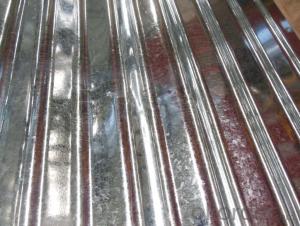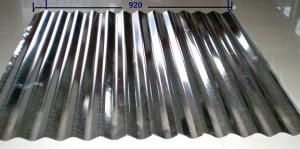Galvanized Corrugated Sheets
- Loading Port:
- China Main Port
- Payment Terms:
- TT OR LC
- Min Order Qty:
- -
- Supply Capability:
- -
OKorder Service Pledge
Quality Product, Order Online Tracking, Timely Delivery
OKorder Financial Service
Credit Rating, Credit Services, Credit Purchasing
You Might Also Like
Specifications
Corrugated gi/gl/ppgi Sheet
1.Thickness: 0.13mm-1.0mm
2.Width:750mm-1250mm
3. z40-z150g/m2
4.ISO 2000,SGS
- Q: Can steel sheets be used for magnetic applications?
- Yes, steel sheets can be used for magnetic applications, but their magnetic properties are generally weaker compared to materials specifically designed for magnetic applications such as iron or alloys like neodymium magnets.
- Q: Can the steel sheets be used for magnetic shielding?
- Yes, steel sheets can be used for magnetic shielding. Steel is a ferromagnetic material, which means it can effectively redirect and absorb magnetic fields. When steel sheets are used to shield against magnetic fields, they create a barrier that helps to prevent the penetration of magnetic flux into a designated area. This property makes steel sheets an excellent choice for applications where magnetic shielding is required, such as in electronics, medical devices, and sensitive laboratory equipment. However, the effectiveness of steel sheets for magnetic shielding can depend on various factors, including the thickness and composition of the steel, as well as the strength and frequency of the magnetic field being shielded. Therefore, it is important to consider these factors and consult with experts to ensure the appropriate steel sheets are selected for optimal magnetic shielding.
- Q: Can steel sheets be used for signage or advertising displays?
- Yes, steel sheets can be used for signage or advertising displays. They provide a durable and long-lasting option, and can be customized with various finishes and designs to suit individual preferences and branding requirements. Additionally, steel sheets offer a sleek and professional look, making them suitable for both indoor and outdoor applications.
- Q: What are the different methods of surface cleaning for steel sheets?
- There are several methods available for surface cleaning of steel sheets, each with its own advantages and applications. 1. Mechanical Cleaning: This method involves using abrasive materials such as sandpaper, wire brushes, or abrasive blasting to physically remove dirt, rust, and other contaminants from the surface of the steel sheets. Mechanical cleaning is effective for heavy-duty cleaning and preparing the surface for further treatment or coating. 2. Chemical Cleaning: Chemical cleaning involves the use of chemicals or detergents to dissolve or remove contaminants from the steel surface. This method is particularly useful for removing grease, oil, and other organic substances. It is important to choose the appropriate chemical cleaner based on the type of contamination and the steel sheet's composition to ensure effective cleaning without damaging the surface. 3. Electrolytic Cleaning: Electrolytic cleaning employs an electrolyte solution and an electric current to remove contaminants from steel sheets. The steel sheet is submerged in the electrolyte bath, and the electric current causes the contaminants to dissolve and separate from the surface. This method is effective for removing stubborn rust, scale, and oxidation, and it can also provide a polished finish to the steel surface. 4. Power Washing: Power washing, also known as pressure washing, uses a high-pressure water stream to clean the steel surface. This method can effectively remove loose debris, dirt, and mild contaminants. Power washing is a quick and efficient method, but it may not be suitable for heavy-duty cleaning or for removing stubborn contaminants like rust. 5. Vapor Degreasing: Vapor degreasing is a technique that uses solvent vapors to clean the steel surface. The steel sheet is exposed to the solvent vapors, which dissolve and remove contaminants. This method is particularly effective for removing oil, grease, and other organic substances. Vapor degreasing is a precise and controlled cleaning method, commonly used in industrial applications. It is important to consider the type and severity of contamination, the desired level of cleaning, and the specific requirements of the steel sheets before choosing a surface cleaning method. Additionally, safety precautions and appropriate protective equipment should always be used when performing any surface cleaning procedure.
- Q: Are the steel sheets available in different grades?
- Yes, steel sheets are available in different grades. Steel is classified into various grades based on its composition, strength, and other properties. These grades include carbon steel, stainless steel, alloy steel, and tool steel, among others. Each grade has its own unique characteristics and is suitable for different applications. The choice of grade depends on factors such as the required strength, corrosion resistance, and cost-effectiveness for the specific application. Therefore, when purchasing steel sheets, it is important to consider the grade that best suits the intended use.
- Q: What is the standard thickness of steel sheets?
- The standard thickness of steel sheets can vary depending on the specific application and industry. However, common standard thicknesses range from 0.5mm to 25mm.
- Q: What are the common thicknesses for aluminum-coated steel sheets?
- The common thicknesses for aluminum-coated steel sheets typically range from 0.015 inches to 0.125 inches.
- Q: Can the steel sheets be used for elevator doors?
- Indeed, elevator doors can utilize steel sheets. Given steel's robustness, longevity, and fire-resistant attributes, it serves as a prevalent choice for constructing elevator doors. By manipulating and tailoring steel sheets, they can be customized to precisely match the dimensions and specifications of the elevator doors, ensuring a dependable and secure enclosure. Moreover, steel sheets can be treated with diverse coatings and finishes to augment their aesthetic appeal while safeguarding them against corrosion.
- Q: Are steel sheets easy to weld?
- Yes, steel sheets are generally easy to weld due to their high heat conductivity, allowing for efficient and smooth welding processes.
- Q: Can steel sheets be used for food processing or storage?
- Yes, steel sheets can be used for food processing or storage. Steel is a durable and hygienic material that is commonly used in the food industry due to its resistance to corrosion, easy cleaning, and ability to maintain proper food safety standards.
Send your message to us
Galvanized Corrugated Sheets
- Loading Port:
- China Main Port
- Payment Terms:
- TT OR LC
- Min Order Qty:
- -
- Supply Capability:
- -
OKorder Service Pledge
Quality Product, Order Online Tracking, Timely Delivery
OKorder Financial Service
Credit Rating, Credit Services, Credit Purchasing
Similar products
Hot products
Hot Searches
Related keywords




























